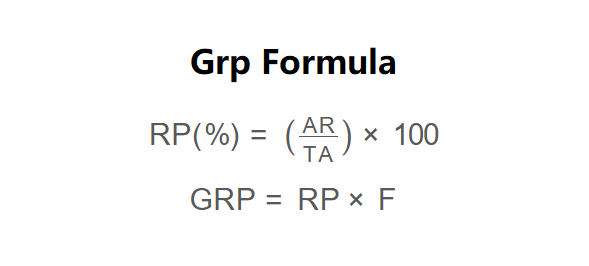 Home
Home
 Back
Back

Definition: This calculator computes the Gross Rating Point (GRP), a metric used in advertising to measure the impact of a campaign by combining the percentage of the target audience reached (Reach Percentage) with the average number of times each viewer sees the ad (Frequency per Viewer). It provides a standardized way to assess campaign exposure.
Purpose: It is used by advertisers to evaluate the effectiveness of ad campaigns across media channels, optimize media planning, allocate budgets efficiently, and ensure campaigns reach the desired audience with sufficient frequency to drive impact.
The calculator uses the following formulas, as shown in the image above:
\( \text{RP} (\%) = \left( \frac{\text{AR}}{\text{TA}} \right) \times 100 \)
\( \text{GRP} = \text{RP} \times \text{F} \)
Where:
Steps:
Calculating the GRP is essential for:
Example 1: Calculate the Reach Percentage and GRP for a campaign with a total audience of 10,000, an audience reached of 2,000, and a frequency per viewer of 4:
Example 2: Calculate the Reach Percentage and GRP for a campaign with a total audience of 50,000, an audience reached of 15,000, and a frequency per viewer of 3:
Q: What is a good GRP value?
A: A good GRP depends on campaign goals, but media planners often recommend 150 GRPs over three consecutive months for significant awareness, assuming a reach of 50–90% and a frequency of at least 3 exposures to prompt viewer action.
Q: How does GRP differ from TRP?
A: GRP measures exposure across the total audience, while TRP (Target Rating Point) focuses on a specific demographic within that audience, offering a more targeted metric for campaign performance.
Q: How can a business improve its GRP?
A: Businesses can improve GRP by increasing reach (e.g., targeting a broader audience or using multiple channels) or frequency (e.g., airing ads more often), optimizing ad design, and ensuring strategic placement for maximum visibility.